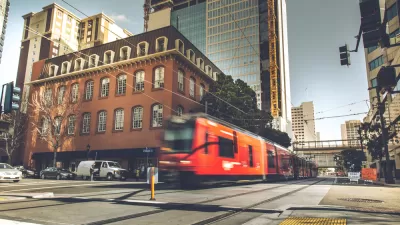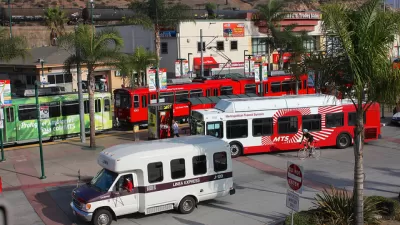In 2021, San Diego will open a northern trolley extension connecting its downtown and Golden Triangle. However, much of the route in between is barren and inaccessible. AIA-SD urges density and more effort to win over opponents.
In 2021, San Diego's light rail "trolley" system will open a northern leg, called the "Mid Coast Corridor." It will connect La Jolla, the Golden Triangle, UCSD, the V.A. Hospital, the city's Bio-Med industry, and neighborhoods in between, to downtown, the border, and the rest of the trolley system. Needless to say, its a critical corridor in the city's transit infrastructure. Finally, the coastal city and surrounding communities will have a light rail transit system with a hub downtown that goes in the core directions of north, south, and east.
Unfortunately, a large portion of the extension uses existing heavy rail right-of-way, runs adjacent and parallel to I-5, and borders urbanized areas on only one side—at the bottom of a steep hill that runs much of the length of the extension. Such is the reality of building light rail late in urban development. Moreover, the urbanized areas abutting the extension are low density and car oriented. Much of the middle portion of the extension is not very accessible, particularly to pedestrians and bicyclists.
These conditions were to be partially remedied by "The Morena Corridor Specific Plan," which was to facilitate transit oriented development. In 2014, a neighborhood backlash against lifting a 30-foot height limit to allow six-story transit oriented development near a station along the line scuttled the Specific Plan. In an open letter, AIA San Diego revisits the necessity of facilitating transit oriented development along the extension:
All communities must share responsibility for meeting housing and transportation infrastructure needs for the greater good of the region. Adding housing, creating transportation nodes, fostering retail & commercial services and committing to expanded public amenities enhances neighborhoods, making them better places to live, work, study, play and raise families. Increased density at Tecolote and other stations along the Corridor and throughout the region will create livable communities for the workforce that makes the city function – teachers, police, nurses, mechanics, chefs and servers, designers and many others. This approach fosters prosperity, prepares us for the exciting future promised by emerging transportation and energy technologies, and builds resilience against the environmental challenges that we will experience soon.
AIA-SD urges reconsideration and adoption of the Specific Plan:
We support our public officials, the Morena Corridor Specific Plan, and local developers that advocate for thoughtful, effective growth, and economic development of our neighborhoods.
For the the full letter from AIA, see the source article.
FULL STORY: Support the Morena Corridor Specific Plan

Montreal Mall to Become 6,000 Housing Units
Place Versailles will be transformed into a mixed-use complex over the next 25 years.

Planetizen Federal Action Tracker
A weekly monitor of how Trump’s orders and actions are impacting planners and planning in America.

DARTSpace Platform Streamlines Dallas TOD Application Process
The Dallas transit agency hopes a shorter permitting timeline will boost transit-oriented development around rail stations.

Study: 4% of Truckers Lack a Valid Commercial License
Over 56% of inspected trucks had other violations.

Chicago Judge Orders Thousands of Accessible Ped Signals
Only 3% of the city's crossing signals are currently accessible to blind pedestrians.

Philadelphia Swaps Car Lanes for Bikeways in Unanimous Vote
The project will transform one of the handful of streets responsible for 80% of the city’s major crashes.
Urban Design for Planners 1: Software Tools
This six-course series explores essential urban design concepts using open source software and equips planners with the tools they need to participate fully in the urban design process.
Planning for Universal Design
Learn the tools for implementing Universal Design in planning regulations.
City of Mt Shasta
City of Camden Redevelopment Agency
City of Astoria
Transportation Research & Education Center (TREC) at Portland State University
US High Speed Rail Association
City of Camden Redevelopment Agency
Municipality of Princeton (NJ)




























